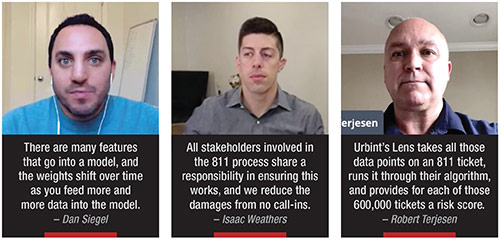Memorable Moments
Emeka Igwilo is Chief Data Officer at Southern Company Gas.


Damage prevention is of major importance at utilities companies. Doing that effectively became more difficult when COVID hit early this year, a complicating factor. Fortunately, Urbint is there to partner with utilities.
That's why at Urbint Anticipate, the marquee conference on field risk mitigation and the future of safety in utilities, the PUF team attended online to bring you memorable and meaningful moments from that conference. The safety experts were there to weigh in.
Not only that, but you don't want to miss a huge announcement made by Urbint at the conference. Yep, that is right, and it has to do with new predictive AI technology that identifies safety threats to workers in the field, enabling supervisors to prevent serious injuries and fatalities. It is huge, so read on to find out more.
Southern Company Gas, Chief Data Officer, Emeke Igwilo: When COVID hit, our biggest fear was, will our locators have enough people if there's an outbreak. A couple of weeks into it, what hit me was the biggest thing we needed to guard against was incidents that created clusters. If you have a mass outage it creates a need for employees to cluster to respond to it, and those were things we wanted to avoid.
We started thinking about how do we organize to make sure we limit the ability for critical incidents that would cause clustering? We looked at the urban model we were using, and it was weighted toward likelihood of risk, and of failure.
It's trying to find every damage. We worked to say, let's tweak the model. Let's prioritize critical assets. These were our one-way feeds to hospitals and nursing homes, areas of high consequence.
We created a consequence model that now we prioritize, how we look at tickets that were targets for intervention. In tandem with that, we deputized some of the workers that weren't doing a lot of maintenance work that required us to go inside.
We had a few excess resources. We deputized those guys and went through a crash course in damage prevention. Those who were able to locate already were able to use them as intervention, but for those who couldn't, we would send them to watch and protect dig sites that were close to critical areas.
We did not have one incident throughout this process and it was successful. It's part of that, being able to pivot, modify that model, and time to market that allowed us to do that and be effective. That's what we have to do in reaction to COVID.
Puget Sound Energy, Damage Prevention Program Manager, Erika Hunter: April was a constant panic attack with homeowners getting out there. They were like, I want to do everything now.
We did a lot of social media campaigning in Washington state. Our homeowner call volume has continued to steadily increase. That's been huge. We're completing a new ad campaign focused, not just on the safety of digging, but also on the monetary consequences, because we did a few focus groups with homeowners and asked, what would make you call?
It wasn't that their house could blow up. It was that they were going to get a bill. We have a Gas Public Awareness manager and she does a lot of work measuring the successful results of that tracking from month to month, if our call volume has gone up.
We've seen good success with that. When we're working with our urban risk scores, now we have risk tickets that came in from homeowners. We educate them and ask them to pass that information along to their neighbors.
We also have a safety ticket program in Washington state. What that means is, a neighbor identifies somebody that's digging without an 811 ticket. They can call in and say, hey, I need a safety ticket.
We will go and see that person. We also go randomly. If my reps are out in the field and see somebody digging, and don't see marks, they will stop, start talking to that person, and explain the importance of safe digging. There's a lot we do in that regard, but our Washington 811 board has an excellent marketing program, and that's been beneficial.
BetterKloud, Damage Prevention Consultant, Isaac Weathers: Historically people viewed that as part of the job of the 811 center, to educate and market 811 in general. They've done a good job. If you look at the numbers of the past few years, the data shows awareness is at an all-time high.
Awareness of the process of how you call 811, contact 811, that's out there, but we still see this problem from no call-ins, and that's staying the same. Ultimately, all stakeholders involved in the 811 process share a responsibility in ensuring this works, and we reduce the damages from no call-ins, whether it's from enforcement by regulators, and letting people know, hey, this is a serious problem.
National Grid Damage Prevention Manager, Robert Terjesen: Each 811 ticket is more or less the same no matter what state you're in in North America. Each ticket has basic information on it.
It has the name of the excavator. It has the type of work that excavator is planning to do. It has the location of that work, the type of equipment they're going to use, and while all of that is basic information, there is a lot of valuable information behind each one of those data points.
What does that mean? Urbint is able to take a look at the history of each of those excavators and provide a weight to that excavator name field. ABC Contracting has a poor history with National Grid. When that name pops up on an 811 ticket, it's provided a greater weight than Mom and Pop Excavating down the street. They're much better at digging. They're not risked as highly as ABC Contracting.
The same thing applies to all the other data points on an 811 ticket. Urbint's Lens takes all of those data points on an 811 ticket, runs it through their algorithm, and provides for each 811 ticket, each of those six hundred thousand tickets a risk score. The higher the risk, the greater the potential for damage on that dig site.
This is allowing National Grid to take our limited resources, and to place them, before the backhoe is turned on, at the job site with the excavator, with that risky excavation, and have a conversation with the excavator, explain to them why they are here, what is making this job site riskier than another, and explain what some of the challenges are going to be as they progress throughout that job.
Urbint, Head of Customer Success, Dan Siegel: To the question of how are weighting factors done, every model is going to be unique to that customer and to those damages, and the actual weights are going to move around over time, which is the reason why a machine learning model is really powerful.
It might be heavily weighted toward excavators that have historical damages, and then an excavator shows a period of time of not having damages. The weight that goes to that excavator or excavators in general might come down. But that's kind of the nature of modelling. There are hundreds, not dozens, but there are definitely many features that go into a model, and the weights shift over time as you feed more and more data into the model.
Category (Actual):
Department:
